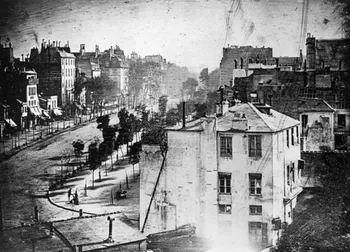The earliest forms of photography, heliographs and daguerreotypes, produced many historically significant images in their early years.
Our story on the beginning of photography continues after this advertisement:
Some of these important early photographs include:
First Successful Permanent Photograph & Oldest Surviving Camera Photograph:
“View from the Window at Le Gras” stands as the oldest surviving camera photograph and is a heliographic image.
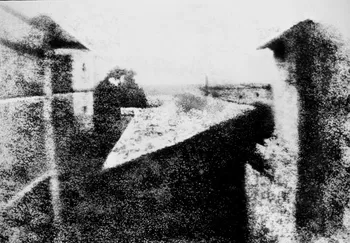
This remarkable image was crafted by the French inventor Joseph Nicéphore Niépce in 1826 within the confines of Saint-Loup-de-Varennes, France.
The image shown here is an enhanced version by Helmut Gersheim in 1952 from the damaged original plate.
Due to the 8-hour exposure, the buildings are illuminated by the sun from both right and left. Without Niépce’s experiments, Louis Daguerre would have been able to build on them to adapt and improve what turned out to be the daguerreotype process.
The oldest photo studio and laboratory in the world, the birthplace of photography, owned by Nicéphore Niépce, is now a museum dedicated to photography.
Oldest Known Daguerreotype
“The Artist’s Studio / Still Life with Plaster Casts”, made by Louis Daguerre in 1837 is the earliest reliably dated daguerreotype.
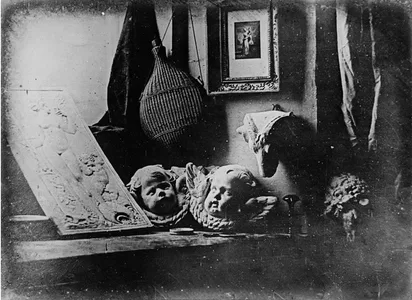

Louis-Jacques-Mandé Daguerre’s earliest surviving photograph was created two years prior to the official announcement of the invention of the daguerreotype in 1839.
These unique images offer remarkable clarity and intricate details, all captured on small, mirrored, silver-coated copper plates.
Only about 25 of Daguerre’s images have survived the test of time.
Much like many of the pioneering figures in photography, Louis Daguerre, who hailed from the world of Parisian theatrical set design and showmanship, viewed this new medium as an amalgamation of art and science.
The First Photograph of a Person
One of Louis Daguerre’s earliest successful daguerreotypes dating back to 1838, “The Boulevard du Temple” is believed to be the first photograph to capture a human being.


It shows a busy street in Paris, but because of the long exposure time, a man getting his shoes shined is the only person in the image. The rest of the street appears deserted because the busy Parisians going about their business were not standing still long enough for their image to register on the plate.
First Astronomical Photograph – The First Photograph of the Moon:
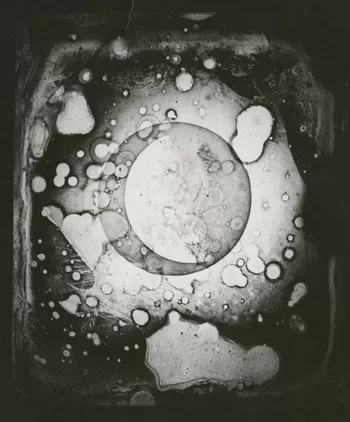

“Moon Daguerreotype” by John William Draper, an American physician and chemist, who captured the first daguerreotype of the moon in 1839.
Although it was a small and rudimentary image, it marked the beginning of lunar photography.
It was taken on March 26, 1840 from the rooftop observatory at New York University.
On March 16, 1840, he wrote in his laboratory notebook, “This evening I exposed a prepared plate to the moonbeams which had been conveyed by a double convex lens.”
Between 1839 and 1840, Draper dedicated his efforts to conquering the complexities associated with producing daguerreotype portraits.
His collaboration with Samuel Morse led to the establishment of a daguerreotype studio, one of the pioneering endeavors of its kind, situated on the rooftop of New York University in the spring of 1840.
The First Photographic Studio
In 1839, Robert Cornelius, an American pioneer in photography, took The World’s First Self Portrait outside his family’s gas lamp store in Philadelphia.
This is often regarded as one of the earliest photographic self-portraits and possibly the first known photographic portrait of a person.
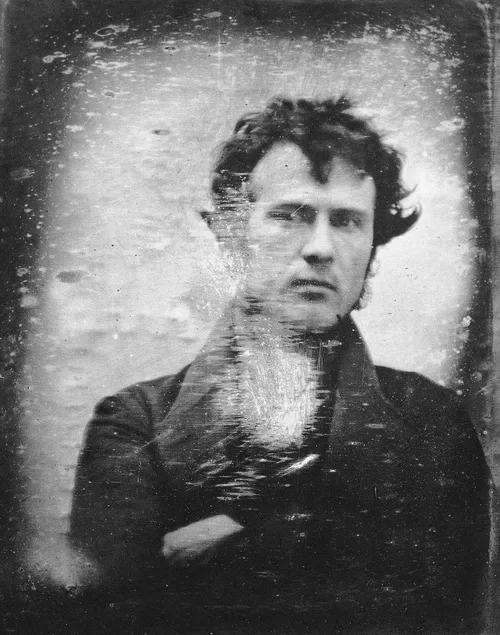

Many daguerreotypists opened studios to create portraits of ordinary citizens. The studio portraits of couples, families, and individuals are valuable historical records that provide insights into fashion, social status, and everyday life in the 19th century.
Early daguerreotypists quickly recognized the value of the process for portraiture. Images of famous individuals from the 1840s and 1850s include the likes of Edgar Allan Poe, Abraham Lincoln, and Frederick Douglass.
The oldest surviving Daguerreotype in Australia
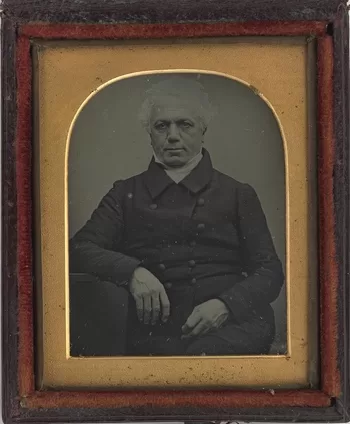

The earliest surviving photograph known to have been taken in Australia is a daguerreotype portrait of Dr. William Bland, created by George Baron Goodman, Australia’s first professional photographer in 1844 or 1845.
Mr Goodman had been making portraits in Australia since 1841, but this is the oldest known daguerreotype to have survived the test of time.
Captain Augustin Lucas is credited with capturing the first photograph in Australia in 1841 with his daguerreotype of Bridge Street in Sydney. No copies of Captain Lucas’ streetscape photograph are known to exist.
Early Medical and Scientific Imagery: Daguerreotypes were also employed for documenting medical conditions, scientific specimens, and anatomical studies. Notable examples include images of surgical procedures and medical conditions from the 1840s.
Early Landscape Photography: Some of the earliest daguerreotypes captured landscapes and cityscapes. These images provided a visual record of the rapidly changing urban environments of the 19th century.
These early daguerreotypes not only hold historical significance but also laid the foundation for the development of photography as a medium for documenting the world, recording history, and expressing artistry. They offer a unique window into the past and continue to be celebrated for their contribution to the history of visual culture.
Further reading
Related stories:
Guide to Collecting Vintage Film Cameras
Glossary of photography terms for auction & collectors – with examples
FEATURE: Collecting Old & Vintage Photographs
Life Magazine’s Innovative Photography at MFA Boston
NASA’s Famous Blue Marble Photo Is 50 Years Old
Man Ray’s love-hate relationship with Hollywood
Fake Photo: Manipulated photography before Photoshop
Faked photos for Soviet propaganda



